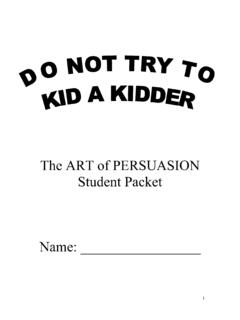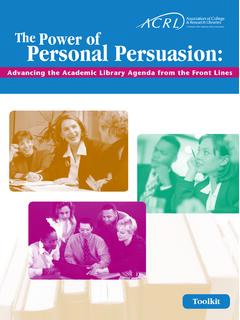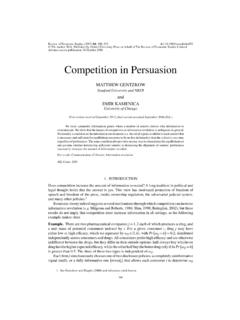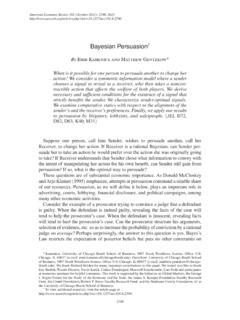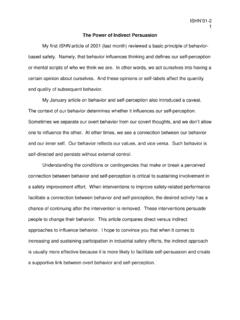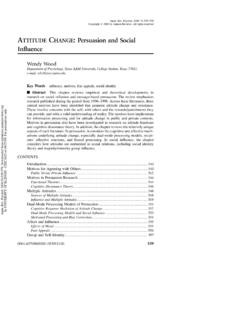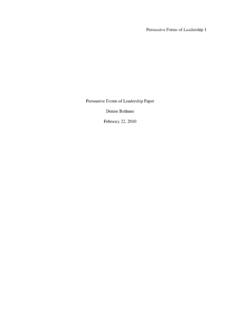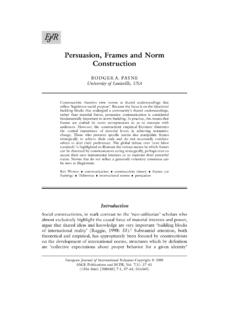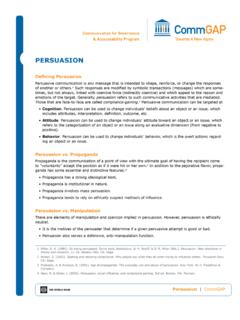Transcription of Persuasion Across Time and Space - Understanding Language
1 Understanding Language | Language , Literacy, and Learningin the Content AreasNovember 2012 Persuasion Across time and Space : Analyzing and Producing Persuasive Texts1{ } Across time and Space : Analyzing and Producing Complex TextsA Unit Developed for the Understanding Language Initiative by WestEd s Teacher Professional Development ProgramUnit Authors: Aida Walqui, Nanette Koelsch, and Mary SchmidaIn Collaboration with Understanding Language s English Language Arts Working Group: George C. Bunch (Chair), Martha Inez Castell n, Susan Pimentel, Lydia Stack, and Aida WalquiIntroduction to ReadersThe goal of this unit is to provide exemplars illustrating how English Language Arts Common Core Standards in Reading Informational Text and Writing Arguments can be used to deepen and accelerate the learning and instruction of English Language Learners (ELLs), especially at the middle school level.
2 It is based on the notion that ELLs develop conceptual and academic understandings as well as the linguistic resources to express them simultaneously, through participation in rigorous activity that is well scaffolded. Practices focus student attention and activity on key concepts -which are pre-sented and discussed in their interrelatedness- with invitations for students to engage in higher order thinking through-out. These practices, and the intentional support offered to students throughout the unit, are designed to constitute an apprenticeship for students that over time builds their agency and autonomy. This unit was designed for students who have reached at least an intermediate level of proficiency in English (see Level 3 in the Framework for English Language Development Proficiency Standards1).
3 Effective implementation of the unit also assumes a teacher who is both knowledgeable about the critical role of Language envisaged in the CCSSs and knows how to support students learning, strengthening their Language and literacies development Across the ELA curriculum. In many cases, supporting teachers in the development of this knowledge and set of skills will require some professional development prior to their teaching the unit. Pedagogically, the unit signals several important shifts in the design of learning materials and instructional approaches:1 Council of Chief State School Officers. (2012). Framework for English Language Proficiency Development Standards corresponding to the Common Core State Standards and the Next Generation Science Standards.
4 Washington, DC: { } a conceptualization of To understandingLanguage acquisition as an individual processJLanguage acquisition as a social process of apprentice-ship that takes place in social contextsLanguage as structures or functionsJLanguage as action, subsuming structure and function (Ellis, N. & Larsen-Freeman, D., 2010; van Lier & Walqui, 2012) Language acquisition as implying the linear and pro-gressive building on forms and structures, or functions, aimed at accuracy, fluency, and complexityJNon linear and complex developmental process aimed at communication and comprehensionUse of individual ideas or texts as the center of instructionJAttention to ideas in their interrelatedness, and teach-ing units as a cluster of lessons centered on texts that are interconnected by purpose and/or themeUse of simple and/or simplified textsJUse of complex, amplified texts for all students Use of activities that pre-teach the content, or simply help students get through texts JActivities that scaffold students development and their autonomy.
5 So that the knowledge gained will assist them in generating new understandings on their own in the futureIdentifying discrete structural features of languageJExploration of how Language is purposeful and pat-terned to do its particular rhetorical workTraditional grammar as a starting point for students to know about languageJMultimodal grammar as necessary to support students Understanding of the visual, spatial, gestural, audio and linguistic meanings of textsObjectives stated as dichotomies (such as content objectives and Language objectives )JObjectives revolve around ways of engaging in aca-demic practices, communicating, doing, and being by using Language for different audiences and purposesTeacher use of standardized or pre-fabricated tests to guide instruction JInstruction guided by assessment of students par-ticipation in activity, and a determination of how they need to be supported next to develop in deep and generative ways.
6 How did we begin the design of this unit?We began the design of the unit looking for a set of ELA standards that would contribute to the development of students critical analysis of discourse and foster their curiosity about how Language works. The ELA Writing CCSS address three major types of text: narrative, argument, and informative/explanatory. We reasoned that argumentation was not only a central component of the standards but that students ability to delineate and evaluate the argument and specific claims in a ( , for example) is an essential 21st century skill. With the selection of this text type we then looked for read-ing texts that would best support the reading and writing of arguments and develop literacies for the 21st in a world characterized by social and economic tensions, ELLs and other teenagers struggle to make sense of their circumstances.
7 With 2012 being an election year in the United States, students have likely listened to political speeches on television, commentaries on the radio, and may have read position essays or opinion pieces in newspapers or magazines. These ideas led us to choose speeches as the main text type for the unit, a genre typically characterized as { } takes communicative practice along the continuum from argument which includes the use of logical evi-dence- to ethics and emotion, through the appeals of ethos and pathos. Being able to understand whether texts com-municate propositions that appeal not only logically, but also to an ethical sense -or not- is essential in contemporary life. Following this reasoning, we decided to choose speeches that would help students travel through social and economic tensions in America Across time , anchoring the exploration in famous oratory pieces, which would invite students to focus on how speakers and writers craft Language in a wide variety of ways in order to induce their audience(s) to take a particular position and/or to take action.
8 There were many speeches to choose from, each presenting us with its own rationale for inclusion. In the end we decided to start with the Gettysburg Address both because of its pivotal role in American history, but also because its pedagogi-cal treatment could clearly illustrate how to effectively scaffold for English Language Learners the reading of a brief but extremely complex, accomplished, and sophisticated text. Next, we chose King s I Have a Dream and Robert Kennedy s impromptu speech upon learning of King s assassination. In order to present a counter perspective in the ideological debate that has spanned Across time in history, we included George Wallace s The Civil Rights Movement: Fraud, Sham, and Hoax. Finally, Barbara Jordan s essay All Together Now was selected to close the historical set because she revisits tensions addressed by the other speeches with a sense of hope and an appeal to all to do our part in creating a more humane society.
9 So, we had the main texts selected. We then asked ourselves how the unit should begin and close. We made the decision to get the unit started with an analysis of multimedia advertisements, a type of persuasive text that is familiar to students, but that they seldom critique in rational ways, and with the use of explicit tools to look at the framing of arguments and appeals. Adolescents in the contemporary world are surrounded by multimodal commercial advertisements that try to convince them of the goodness or value of products they are encouraged to buy or positions they should support. They need to evaluate the arguments presented and the claims made in these texts. We wanted to choose some ads that followed in the spirit of civic activism and others that were more commercial.
10 We also wanted some ads that were not familiar to students, and some that were. You will see in the opening lesson that we chose some advertisements created in this country and some from abroad. To close the unit we decided to bring the ideas once again close to the lives of students and chose a speech written by Severn Cullis-Suzuki, a Canadian 12 year old, who addressed the 1992 United Na-tions Earth Summit in Brazil. Reading and examining a speech written by somebody close to them in age, students would be motivated to write a persuasive text of their own applying what they had learned throughout the unit. As used in schooling, persuasive texts allow students to acquire and demonstrate a wide repertoire of practices that involve their literacy skills, understandings, and the power of Language .

